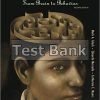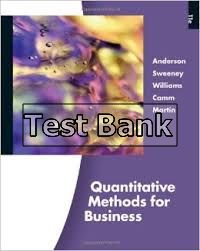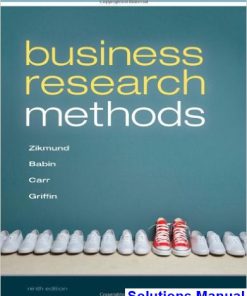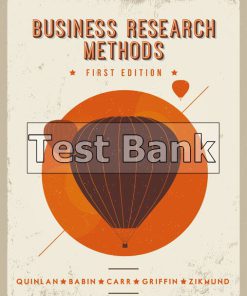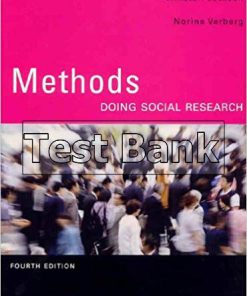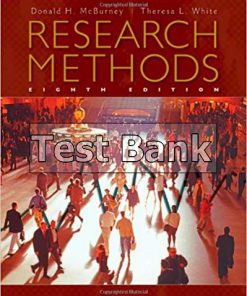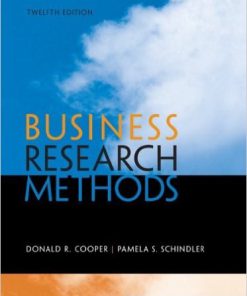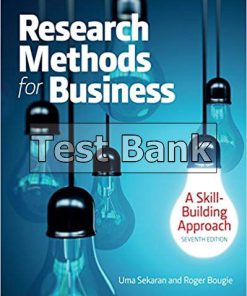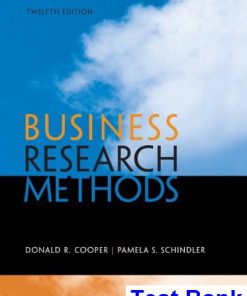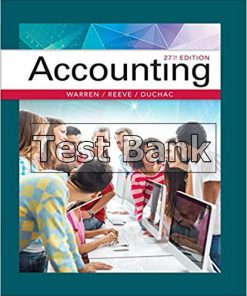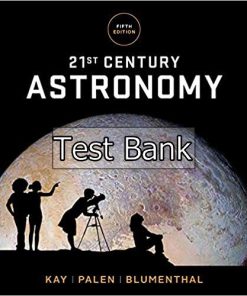Business Research Methods 11th Edition Cooper Test Bank
$50.00 Original price was: $50.00.$26.50Current price is: $26.50.
Business Research Methods 11th Edition Cooper Test Bank.
This is completed downloadable of Business Research Methods 11th Edition Cooper Test Bank
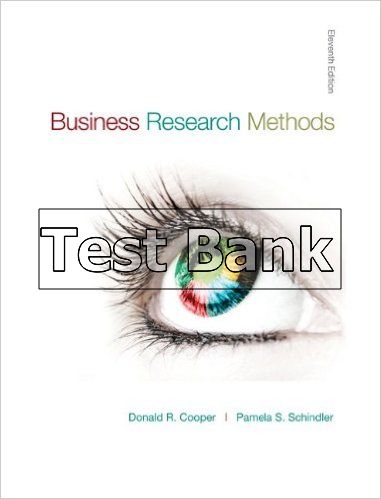
Product Details:
- ISBN-10 : 0073373702
- ISBN-13 : 978-0073373706
- Author: Donald Cooper (Author), Pamela Schindler (Author)
The Eleventh Edition of Business Research Methods continues to provide the most timely, richest, and most comprehensive coverage of the research experience in Business Research Methods. Students and instructors will find thorough coverage of all business research topics –backed by solid theory. The expertise and practical experience of Cooper and Schindler is evident in the realistic Snapshots, Close-Ups, PicProfiles, and case studies found throughout the text. Managerial decision making is the underlying theme, and topics and applications are presented and organized in a manner that allows students to thoroughly understand the business research function. Consequently, the structure of the text encourages and supports completion of an in-depth business research project during your course.
Table of Content:
- part I. Introduction to Business Research
- Chapter 1. Research in Business
- Why Study Business Research?
- Information and Competitive Advantage
- Goals
- Decision Support
- Business Intelligence
- Strategy
- Tactics
- Hierarchy of Information-Based Decision Makers
- The Research Process: A Preview
- Is Research Always Problem-Solving Based?
- What Is Good Research?
- A Glimpse at Four Research Studies
- ClassicToys
- MedImage
- MoreCoatings
- York College
- What Dilemma Does the Manager Face?
- The Types of Research Studies Represented by the Four Examples
- summary
- key terms
- discussion questions
- cases
- Appendix 1a How the Research Industry Works
- Chapter 2. Ethics in Business Research
- What Are Research Ethics?
- Ethical Treatment of Participants
- Benefits
- Deception
- Informed Consent
- Debriefing Participants
- Rights to Privacy
- Data Collection in Cyberspace
- Ethics and the Sponsor
- Confidentiality
- The Sponsor–Researcher Relationship
- Sponsor’s Ethics
- Researchers and Team Members
- Safety
- Ethical Behavior of Assistants
- Protection of Anonymity
- Professional Standards
- Resources for Ethical Awareness
- summary
- key terms
- discussion questions
- cases
- Chapter 3. Thinking Like a Researcher
- The Language of Research
- Concepts
- Constructs
- Definitions
- Variables
- Propositions and Hypotheses
- Theory
- Models
- Research and the Scientific Method
- Sound Reasoning for Useful Answers
- summary
- key terms
- discussion questions
- cases
- Chapter 4. The Research Process: An Overview
- The Research Process
- Stage 1: Clarifying the Research Question
- Stage 2: Proposing Research
- Resource Allocation and Budgets
- Valuing Research Information
- The Research Proposal
- Stage 3: Designing the Research Project
- Research Design
- Sampling Design
- Pilot Testing
- Stage 4: Data Collection and Preparation
- Stage 5: Data Analysis and Interpretation
- Stage 6: Reporting the Results
- Research Process Issues
- The Favored-Technique Syndrome
- Company Database Strip-Mining
- Unresearchable Questions
- Ill-Defined Management Problems
- Politically Motivated Research
- summary
- key terms
- discussion questions
- cases
- Chapter 5. Clarifying the Research Question through Secondary Data and Exploration
- A Search Strategy for Exploration
- Levels of Information
- Types of Information Sources
- Evaluating Information Sources
- Mining Internal Sources
- Evolution of Data Mining
- Data-Mining Process
- The Question Hierarchy: How Ambiguous Questions Become Actionable Research
- The Management Question
- The Research Question
- Investigative Questions
- Measurement Questions
- summary
- key terms
- discussion questions
- cases
- Appendix 5a Bibliographic Database Searches
- Appendix 5b Advanced Searches
- part II. The Design of Business Research
- Chapter 6. Research Design: An Overview
- What Is Research Design?
- Classification of Designs
- Exploratory Studies
- Qualitative Techniques
- Secondary Data Analysis
- Experience Survey
- Focus Groups
- Two-Stage Design
- Descriptive Studies
- Causal Studies
- summary
- key terms
- discussion questions
- cases
- Chapter 7. Qualitative Research
- What Is Qualitative Research?
- Qualitative versus Quantitative Research
- The Controversy
- The Distinction
- The Process of Qualitative Research
- Qualitative Research Methodologies
- Sampling
- Interviews
- Individual Depth Interviews
- Group Interviews
- Combining Qualitative Methodologies
- Case Study
- Action Research
- Merging Qualitative and Quantitative Methodologies
- summary
- key terms
- discussion questions
- cases
- Chapter 8. Observation Studies
- The Uses of Observation
- Nonbehavioral Observation
- Behavioral Observation
- Evaluation of the Observation Method
- The Observer–Participant Relationship
- Directness of Observation
- Concealment
- Participation
- Conducting an Observation Study
- The Type of Study
- Content Specification
- Observer Training
- Data Collection
- Unobtrusive Measures
- summary
- key terms
- discussion questions
- cases
- Chapter 9. Experiments
- What Is Experimentation?
- An Evaluation of Experiments
- Advantages
- Disadvantages
- Conducting an Experiment
- Selecting Relevant Variables
- Specifying Treatment Levels
- Controlling the Experimental Environment
- Choosing the Experimental Design
- Selecting and Assigning Participants
- Pilot Testing, Revising, and Testing
- Analyzing the Data
- Validity in Experimentation
- Internal Validity
- External Validity
- Experimental Research Designs
- Preexperimental Designs
- True Experimental Designs
- Field Experiments: Quasi- or Semi-Experiments
- summary
- key terms
- discussion questions
- cases
- Appendix 9a Complex Experimental Designs
- Appendix 9b Test Markets
- Chapter 10. Surveys
- Characteristics of the Communication Approach
- Error in Communication Research
- Choosing a Communication Method
- Self-Administered Surveys
- Evaluation of the Self-Administered Survey
- Maximizing Participation in the Self-Administered Survey
- Self-Administered Survey Trends
- Survey via Telephone Interview
- Evaluation of the Telephone Interview
- Telephone Survey Trends
- Survey via Personal Interview
- Evaluation of the Personal Interview Survey
- Selecting an Optimal Survey Method
- Outsourcing Survey Services
- summary
- key terms
- discussion questions
- cases
- part III. The Sources and Collection of Data
- Chapter 11. Measurement
- The Nature of Measurement
- What Is Measured?
- Measurement Scales
- Nominal Scales
- Ordinal Scales
- Interval Scales
- Ratio Scales
- Sources of Measurement Differences
- Error Sources
- The Characteristics of Good Measurement
- Validity
- Content Validity
- Criterion-Related Validity
- Construct Validity
- Reliability
- Practicality
- summary
- key terms
- discussion questions
- cases
- Chapter 12. Measurement Scales
- The Nature of Attitudes
- The Relationship between Attitudes and Behavior
- Attitude Scaling
- Selecting a Measurement Scale
- Research Objectives
- Response Types
- Data Properties
- Number of Dimensions
- Balanced or Unbalanced
- Forced or Unforced Choices
- Number of Scale Points
- Rater Errors
- Rating Scales
- Simple Attitude Scales
- Likert Scales
- Semantic Differential Scales
- Numerical/Multiple Rating List Scales
- Stapel Scales
- Constant-Sum Scales
- Graphic Rating Scales
- Ranking Scales
- Sorting
- Cumulative Scales
- summary
- key terms
- discussion questions
- cases
- Chapter 13. Questionnaires and Instruments
- Phase 1: Revisiting the Research Question Hierarchy
- Type of Scale for Desired Analysis
- Communication Approach
- Disguising Objectives and Sponsors
- Preliminary Analysis Plan
- Phase 2: Constructing and Refining the Measurement Questions
- Question Categories and Structure
- Question Content
- Question Wording
- Response Strategy
- Sources of Existing Questions
- Phase 3: Drafting and Refining the Instrument
- Participant Screening and Introduction
- Measurement Question Sequencing
- Instructions
- Conclusion
- Overcoming Instrument Problems
- The Value of Pretesting
- summary
- key terms
- discussion questions
- cases
- Appendix 13a Crafting Effective Measurement Questions
- Appendix 13b Pretesting Options and Discoveries
- Chapter 14. Sampling
- The Nature of Sampling
- Why Sample?
- What Is a Good Sample?
- Types of Sample Design
- Steps in Sampling Design
- What Is the Target Population?
- What Are the Parameters of Interest?
- What Is the Sampling Frame?
- What Is the Appropriate Sampling Method?
- What Size Sample Is Needed?
- Probability Sampling
- Simple Random Sampling
- Complex Probability Sampling
- Nonprobability Sampling
- Practical Considerations
- Methods
- summary
- key terms
- discussion questions
- cases
- Appendix 14a Determining Sample Size
- part IV. Analysis and Presentation of Data
- Chapter 15. Data Preparation and Description
- Introduction
- Editing
- Field Editing
- Central Editing
- Coding
- Codebook Construction
- Coding Closed Questions
- Coding Open-Ended Questions
- Coding Rules
- Using Content Analysis for Open Questions
- “Don’t Know” Responses
- Missing Data
- Data Entry
- Alternative Data Entry Formats
- On the Horizon
- summary
- key terms
- discussion questions
- cases
- Appendix 15a Describing Data Statistically
- Chapter 16. Exploring, Displaying, and Examining Data
- Exploratory Data Analysis
- Frequency Tables, Bar Charts, and Pie Charts
- Histograms
- Stem-and-Leaf Displays
- Pareto Diagrams
- Boxplots
- Mapping
- Cross-Tabulation
- The Use of Percentages
- Other Table-Based Analysis
- summary
- key terms
- discussion questions
- cases
- Chapter 17. Hypothesis Testing
- Introduction
- Statistical Significance
- The Logic of Hypothesis Testing
- Tests of Significance
- Types of Tests
- How to Select a Test
- Selecting Tests Using the Choice Criteria
- One-Sample Tests
- Two-Independent-Samples Tests
- Two-Related-Samples Tests
- k-Independent-Samples Tests
- k-Related-Samples Tests
- summary
- key terms
- discussion questions
- cases
- Chapter 18. Measures of Association
- Introduction
- Bivariate Correlation Analysis
- Pearson’s Product Moment Coefficient r
- Scatterplots for Exploring Relationships
- The Assumptions of r
- Computation and Testing of r
- Simple Linear Regression
- The Basic Model
- Concept Application
- Method of Least Squares
- Predictions
- Testing the Goodness of Fit
- Nonparametric Measures of Association
- Measures for Nominal Data
- Measures for Ordinal Data
- summary
- key terms
- discussion questions
- cases
- Chapter 19. Multivariate Analysis: An Overview
- Introduction
- Selecting a Multivariate Technique
- Dependency Techniques
- Multiple Regression
- Discriminant Analysis
- MANOVA
- Structural Equation Modeling
- Conjoint Analysis
- Interdependency Techniques
- Factor Analysis
- Cluster Analysis
- Multidimensional Scaling
- summary
- key terms
- discussion questions
- cases
- Chapter 20. Presenting Insights and Findings: Written Reports
- Introduction
- The Written Research Report
- Short Reports
- Long Reports
- Research Report Components
- Prefatory Items
- Introduction
- Methodology
- Findings
- Conclusions
- Appendices
- Bibliography
- Writing the Report
- Prewriting Concerns
- Writing the Draft
- Presentation Considerations
- Presentation of Statistics
- Text Presentation
- Semitabular Presentation
- Tabular Presentation
- Graphics
- summary
- key terms
- discussion questions
- cases
- Chapter 21. Presenting Insights and Findings: Oral Presentations
- Introduction
- Aristotle’s Three Principles of Persuasive Communication
- Ethos
- Pathos
- Logos
- Plan
- Audience Analysis
- Types of Learners
- Keep Your Audience from Checking Out
- Planning and the Web-Delivered Presentation
- Organize
- Traditional Patterns of Organization
- The Motivated Sequence Organization
- The Narrative Organization
- The Rule of Three and the Three-Point Speech
- Support
- Conveying Personal Experience through Stories
- Demonstrations
- Visualize
- Psychological and Physical Foundations
- Design Principles
- Prescriptions for Better Slides
- Deliver
- Modes of Delivery
- Scripts and Notes
- Details Make a Difference
- Practice and Arrange
- Rehearsal Is Essential
- Controlling Performance Anxiety
- Arrangements for Facilities and Equipment
- summary
- key terms
- discussion questions
- cases
- case index
- appendices
- a. Business Research Requests and Proposals (with Sample RFP)
- Proposing Research
- The Request for Proposal (RFP)
- Creating the RFP
- The Research Proposal
- Sponsor Uses
- Researcher Benefits
- Types of Research Proposals
- Internal Proposals
- External Proposals
- Structuring the Research Proposal
- Executive Summary
- Problem Statement
- Research Objectives
- Literature Review
- Importance/Benefits of the Study
- Research Design
- Data Analysis
- Nature and Form of Results
- Qualifications of Researchers
- Budget
- Schedule
- Facilities and Special Resources
- Project Management
- Bibliography
- Appendices
- Evaluating the Research Proposal
- Covering Kids RFP
- Background
- Contractual Needs
- Evaluation Task
- Anticipated Time Schedule
- Proposal Instructions
- Review Criteria
- b. Focus Group Discussion Guide
- Background
- c. Nonparametric Significance Tests
- One-Sample Test
- Kolmogorov-Smirnov Test
- Two-Samples Tests
- Sign Test
- Wilcoxon Matched-Pairs Test
- Kolmogorov-Smirnov Two-Samples Test
- Mann-Whitney U Test
- Other Nonparametric Tests
- k-Samples Tests
- Kruskal-Wallis Test
- d. Selected Statistical Tables
- References and Readings
- Glossary
- Photo Credits
- Name
- Company
- Subject
People Also Search:
business research methods cooper
business research methods 11th edition cooper
business research methods 11th edition
business research methods 11th edition testbank download pdf
business research methods 11th edition download scribd
business research methods
Instant download after Payment is complete
You may also like…
Related products
Test Bank


